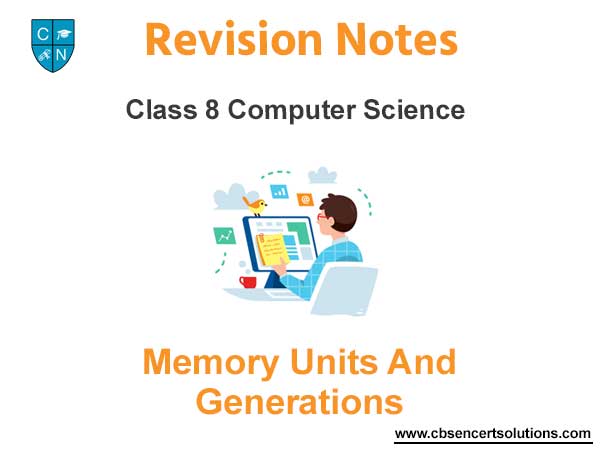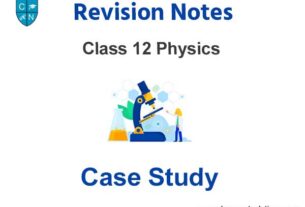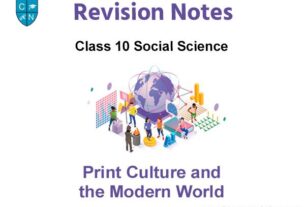Please refer to Memory Units and Generations Class 8 Computer Science notes and questions with solutions below. These revision notes and important examination questions have been prepared based on the latest Computer Science books for Class 8. You can go through the questions and solutions below which will help you to get better marks in your examinations.
Class 8 Computer Science Memory Units and Generations Notes and Questions
Fill in the Blanks
Question 1 A group of __ bits is called a Byte.
a. 8 b. 16 c. 32 d. 64
Answer
8
Question 2 A bit or binary digit may be represented by logical _______ and __________
a. 0,1 b. 0,0 c. 1,1 d. 1,2
Answer
0,1
Question 3 RAM stands for ____________
a. Read Access Memory b. Random Access Memory c. Both a and b d. None of these
Answer
Random Access Memory
Question 4 ROM stands for ______
a. Read Only Memory b. Random Only Memory c. Read Open Memory d. None of the
Answer
Read Only Memory
Question 5 Each track of a disk is divided into small portions know as ___________
a. Sector b. Area c. Disk d. Tape
Answer
Sectors
Write True or False
- Question 1 Group of 8 bits is called Giga Byte.
Answer
False
Question 2 Main memory is faster than cache memory.
Answer
False
Question 3 PROM stands for Programmable Read Only Memory.
Answer
True
Question 4 EPROM stands for Erasable and Programmable Read Only Memory.
Answer
True
Question 5 The surface of disk is divided into a number of invisible concentric circles called tracks.
Answer
True
Short Answer Type of Questions
Question 1 Name the types of Memory.
Ans: Memory is the storage space in Computer where data and instructions are stored. Memory is divided into a
number of small portions which are called Cells. Each cell has a unique address. Memory can be divided broadly into
following two types:
a. Internal Memory
b. External Memory
Question 2 Name the various types of ROM.
Ans: ROM is a Primary Memory. It stands for Read Only Memory. ROM can be divided into the following types:
• MROM (Masked Read Only Memory)
• PROM (Programmable Read Only Memory)
• EPROM (Erasable and Programmable Read Only Memory)
• EEPROM (Electrically Erasable and Programmable Read Only Memory)
Question 3 Write the main features and characteristics of First Generation of Computers.
Ans: Following are the main features and characteristics of First Generation of Computers:
1. Vacuum Tubes were used as main processing components in the computers of this Generation.
2. Electromagnetic Relay Memory was used as primary memory in the computers of this Generation.
3. Punch cards were used as Secondary Memory in the computers of this Generation.
4. Computers of this generation were very large in size and they are also very costly.
5. Computers of this generation produce a large amount of heat.
6. These computers were very unreliable.
Question 4 Write the names of 4th Generation Computers.
Ans: Fourth Generation Computers use VLSI based Integrated Circuits. Some of main computers of these generations
are given below:
• IBM PC
• Apple II
• CRAY I
• CRAY II
• CRAY-X/MP
Question 5 Write the names of areas which are included in AI.
Ans: AI stands for Artificial Intelligence. It is a new branch of Computer Science which enables computers to think
like human beings. Common areas of AI are as given below:
• Robotics
• Game Playing
• Expert System
• Understanding Human Languages
Long Answer Type Questions
Question 1 Explain the External Memory.
Ans: External memory is also known as Secondary Memory or Auxiliary Memory or Permanent Memory. Data can be stored permanently in this memory. It is a Non-Volatile memory whose contents do not lost even after the switching off the computer system.
CPU cannot use this memory directly. Storage capacity of secondary memory is much more as compared to primary memory.
Secondary Memory is cheaper than primary memory, but it is slower in speed as compared to primary memory. Secondary memory is of Magnetic and Optical type. Examples of these memories are given below:

• Magnetic Memory: Floppy Disk Hard Disk etc.
• Optical Memory: CD, DVD etc.
Question 2 Explain the characteristics of Secondary Memory.
Ans: Characteristics of Secondary Memory are given below:
1. It is called Permanent Memory because data can be retained permanently in this memory.
2. It is a Non-Volatile memory whose contents do not lost even after the switching off the computer system.
3. CPU cannot use this memory directly.
4. Storage capacity of secondary memory is much more as compared to primary memory.
5. Secondary Memory is cheaper than primary memory.
6. It is slower in speed as compared to primary memory.
7. Secondary memory is of Magnetic and Optical type.
8. Example of secondary memory are: Floppy Disk, Hard disk, CD, DVD etc.
Question 3-4 What are Tracks and Sectors?
Ans: Tracks and Sectors are the important elements of physical structure of a magnetic disk.
The surface of a disk is divided into a number of invisible concentric circles.
These circles are called Tracks. The number of tracks may vary according to the capacity of the disk.

These tracks are numbered from outward to inward starting from zero. Each track of magnetic disk is further divided into smaller parts, which are called Sectors. Each track may have 8 or more sectors in it. Each sector has the capacity to store 512 bytes. The structure of tracks and sectors can be depicted as shown in the diagram.
Q:uestion 5 Explain the fifth generation of computers.
Ans: Time period of fifth generation is from 1989 to till now. The computers of this generation uses ULSI based
Integrated Circuits. Microprocessor chips were used in these computers. These chips have more than 10 million
components. The computers of this generation are based on the Artificial Intelligence software. Main High level
languages of this generation are C, C++, and Java etc. Internet and Cloud Computing based softwares are mainly
used in this generation. There are many types of fifth generation computers, such as Notebook, Desktop,
Workstations, and Super-Computers etc.



FULL FORMS
ARPANET – ADVANCED RESEARCH PROJECT AGENCY NETWORK
TCP/IP – TRANSMITION CONTROL PROTOCOL
DSL – DIGITAL SUBSCRIBER LINE
ISDN – INTEGRATED SERVICE DIGITAL NETWORK
ISP – INTERNET SERVICE PROVIDER
NIC – NETWORK INTERFACE CARD
IAP – INTERNET ACCESS PROVIDER
URL – UNIFROM RESOURCE LOCATER
EMAIL – ELECTRONIC MAIL
E COMMERCE – ELECTRONIC COMMERCE
FTP – FILE TRANSFER PROTOCOL
SERP – SEARCH ENGINE RESULT PAGE
HTML – HYPER TEXT MARKUP LANGUAGE
KB – KILO BYTE
MB – MEGA BYTE
GB – GIGA BYTE
TB – TERA BYTE
PB – PENTA BYTE
CPU – CENTRAL PROCESSING UNIT
UPS – UNINTERRUPTED POWER SUPPLY
SRAM – STATIC RANDOM ACCESS MEMORY
DRAM – DYNAMIC RANDOM ACCESS MEMORY
MROM – MASKED READ ONLY MEMROY
PROM – PROGRAMMABLE READ ONLY MEMROY
EPROM – ERASABLE PROGRAMMABLE READ ONLY MEMROY
EEPROM – ELECTRICALLY ERASABLE PROGRAMMABLE READ ONLY MEMROY
CD – COMPACT DISK
DVD – DIGITAL VIDEO DISK
bpi – BITS PER INCH
IC I- NTEGRATED CIRCUIT
VLSI – VERY LARGE SCALE INTEGRATED CIRCUIT
ULSI – ULTRA LARGE SCALE INTEGRATED CIRCUIT
AI – ARTIFICIAL INTELLIGENCE
SHORTCUT KEYS
1. Ctrl + A : Select All document
2. Ctrl + B : Bold the selected text
3. Ctrl + C : Copy the selected content
4. Ctrl + F : Find text
5. Ctrl + G : Go to line/page no etc.
6. Ctrl + H : Replace text
7. Ctrl + N : Create a New File
8. Ctrl + O : Open Existing File
9. Ctrl + P : Print File
10. Ctrl + S : Save File
11. Ctrl + V : Paste the Cut/Copied Content
12. Ctrl + W : Close File
13. Ctrl + X : Cut the selected content
14. Ctrl + Y : Redo
15. Ctrl + Z : Undo
16. Ctrl + Shift + C : Copy Formats
17. Ctrl + Shift + V : Paste Formats
18. Alt + F4 : Close Program

We hope the above Memory Units and Generations Class 8 Computer Science are useful for you. If you have any questions then post them in the comments section below. Our teachers will provide you an answer. Also refer to MCQ Questions for Class 8 Computer Science


